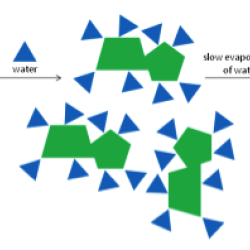Source Institutions
Source Institutions
Add to list Go to activity
Activity link broken? See if it's at the internet archive

In this kitchen chemistry activity, learners explore the chemistry of crystals by making sugar crystals, consider a common chemical reaction type responsible for the rising of muffins and cake in the oven, and study the cleaning power of soap. For some of the experiments, a molecular-level view is fostered using structural diagrams of the chemicals, along with a fun "cartoon" version of the reaction with molecules represented by colored shapes (both drawn and cut out). The activity is written to be part of a kit that can be checked out of the library, but can be done without the kit.
- Under 5 minutes
- 1 to 7 days
- $5 - $10 per group of students
- Ages 8 - 14
- Activity, Experiment/Lab Activity
- English
Quick Guide
Materials List (per group of students)
- white string or thread
- wooden stick or long spoon
- paper clip
- water
- sugar
- small sauce pan
- measuring spoons
- spoon or stirrer
- 2 beakers
- plastic wrap
- notebook
- pen or pencil
- baking soda
- vinegar
- graduated cylinder
- pipette or dropper
- 2 pieces of wax paper
- lipstick
- soap
Subjects
-
Mathematics
-
Measurement
- Units of Measurement
-
Measurement
-
Physical Sciences
- Heat and Thermodynamics
-
Chemistry
- Chemical Bonding
- Chemical Reactions
- Solutions
-
States of Matter
- Solids
- Liquids
- Gases
- Changes of Phase
-
Structure and Properties of Matter
- Atomic Structure
-
The Nature of Science
-
The Scientific Process
- Asking Questions
- Conducting Investigations
- Gathering Data
- Formulating Explanations
- Communicating Results
-
The Scientific Process
Informal Categories
- Food and Cooking
Audience
To use this activity, learners need to:
- see
- read
- touch
Learning styles supported:
- Involves hands-on or lab activities
Other
Components that are part of this resource:
This resource is part of:
Access Rights:
- Free access
By:
- Shaw, Maisie ; Gomez, Maria
Rights:
- All rights reserved, Passport to Chemistry Adventure Program, Mount Holyoke College, 2010
Funding Source:
- Camille and Henry Dreyfus Foundation, Inc.
